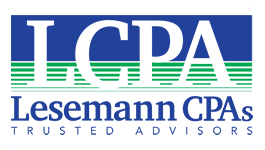
To all of our Clients – with all of the chaos in the world right now, we feel it important to provide you with accurate and verifiable information as we receive it.
Families First Coronavirus Response Act
On Wednesday, March 18, 2020 President Trump signed the “Families First Coronavirus Response Act” into law. Please note there are many sections to this law – all are aimed reducing the severe impact of the Coronavirus (COVID-19) to our country. While we are not experts in every one of these areas, we wanted to let our LCPA Clients be aware of the provisions. There are still multiple parts of this law that have unanswered questions as well as how this will be implemented. This bill has parts for employees as well as employers.
Provisions 1 and 2 address employee coverage assistance and Provision 3 addresses how employers will be protected and reimbursed. It important to understand all three (3) provisions of this Act.
PROVISION 1: Emergency Family and Medical Leave Expansion Act (EFMLEA)
- Applicable to most employers with fewer than 500 employees.
- Employers must provide paid leave under EFMLEA to eligible employees after the first 10 days an employee is out on leave. If provided. employees may use other accrued leave during the first 10-days.
- Eligible employees are defined as those that have been employed for a period of at least 30 days (current FLMA has a 12-month waiting period).
- Only employees that are unable to work due to a lack of childcare (i.e., school closure, daycare closure, etc.) are covered under this provision.
- The paid leave amount is calculated based on an amount not less than two-thirds (66.67%) of an employee’s regular rate of pay (based on the number of hours the employee would normally be scheduled to work). If hours vary week to week, there is guidance available to assist in the calculation.
- The maximum that this Act requires an employer to pay to an employee is $200/day up to an aggregate of $10,000.
- For employers with less than 25 employees, the rules have been altered on job restoration upon that employee’s return.
PROVISION 2: Emergency Paid Sick Leave Act (EPSLA)
- For employers that are in the private sector and have fewer than 500 employees, there are new paid sick leave requirements. To be eligible for payment under this Act, one of the following must be applicable:
- Employee is subject to Federal, State, or local quarantine or isolation order related to COVID-19, OR
- Employee has been advised by a health care provider to self-quarantine due to concerns related to COVID-19, OR
- Employee is experiencing symptoms of COVID-19 and seeking a medical diagnosis, OR
- Employee is caring for an individual who is subject to an order as described in elsewhere in this Act, OR
- Employee is caring for their child if the school or place of care of the child has been closed, OR
- Employee is experiencing any other substantially similar condition specified by the Secretary of Health and Human Services in consultation with the Secretary of the Treasury and the Secretary of Labor.
- Employers are required to give employees paid sick time as follows:
— full time employees – 80 hours
— part time employees – hours equal to the number of hours that such employee works, on average, over a 2-week period
- Wages for employees under #’s 1, 2, and 3 must not be less than the employees regular rate of pay (or minimum wage, if greater). However, the maximum amount required to be paid to an employee on leave for one of these reasons is $511/day up to a total of $5,110 per employee.
- Wages for employees under #’s 4, 5, and 6 must not be less than two-thirds (66.67%) of the employee’s regular rate of pay (or minimum wage, if greater). However, the maximum amount required to be paid to an employee on leave for one of these reasons is $200/day up to a total of $2,000 per employee.
- Sick time under this Act does not carry over to subsequent year(s).
NOTE: The following is applicable to both EFMLEA (Provision 1) & EPSLA (Provision 2) above:
- Language exists in the law that gives the Secretary of Labor authority to issue regulations that can exempt small businesses with fewer than 50 employees from the requirements of these sections “when the imposition of such requirements would jeopardize the viability of the business as a going concern.” (no guidance on this yet).
- Employers may elect to exclude employees who are health care providers and/or emergency responders.
- Employers are eligible for a payroll tax credit equal to the wages paid under these provisions of the law (discussed below).
- Wages paid under these new acts are not considered wages/compensation for employment tax purposes.
- These requirements become effective 15 days after the enactment of the law – April 2, 2020
- The requirements of these acts will expire at the end of this year – December 31, 2020.
Employer Payroll Tax Credits for EFMLEA and EPSLA
- Employers will be allowed a credit against their quarterly payroll taxes 100% of the qualified sick leave wages and/or qualified family leave wages paid by the Employer during the calendar quarter (limited to the maximum amounts required to be paid to employees (as described above).
- This credit amount may be increased by the amount the employer pays or incurs to provide and maintain a group health plan on behalf of the employee during their leave.
- If the credit exceeds the amount of payroll taxes owed, the excess will be refundable.
- The amount of the credit must be included in gross income of the employer and no credit is allowed with respect to wages for which a credit is allowed under section 45S of the Code (Family and Medical Leave Credit).
- There are also provisions within the law that allow Self-Employed individuals to claim a credit.
- The credit does not apply to certain federal, state or local governments.
In addition to the provisions above, there are several health-related provisions (i.e. free testing under all health care insurance plans as well for those that are uninsured). Additional funding as well as expansion of those already in place has been provided for increased unemployment benefits.
We will be monitoring this throughout the following weeks and when we receive verifiable guidance, we will update you accordingly. Should you have questions, please contact us. If we don’t know the answer, we will find it!

